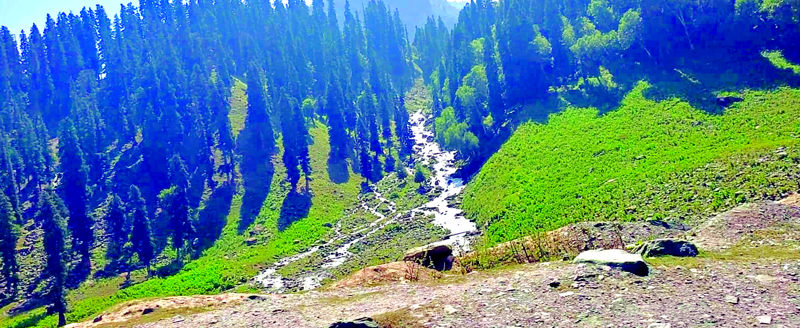Melting of glaciers has accelerated due to heat wave in Kashmir, Ladakh
𝐒𝐭𝐞𝐩 𝐧𝐞𝐞𝐝 𝐭𝐨 𝐛𝐞 𝐭𝐚𝐤𝐞𝐧 𝐭𝐨 𝐩𝐫𝐨𝐭𝐞𝐜𝐭 𝐟𝐫𝐚𝐠𝐢𝐥𝐞 𝐞𝐧𝐯𝐢𝐫𝐨𝐧𝐦𝐞𝐧𝐭 𝐢𝐧𝐜𝐥𝐮𝐝𝐢𝐧𝐠 𝐠𝐥𝐚𝐜𝐢𝐞𝐫𝐬: 𝐞𝐱𝐩𝐞𝐫𝐭𝐬

SHAKEELA ANDRABI
SRINAGAR: In absence of cloud cover, severe heat wave conditions have been consistently reported since the beginning of the summer season in Kashmir and the mercury touched 34.6 degrees Celsius in Srinagar on August 21, could lead for natural disasters in future.
According to weather experts, August month was the hottest after 77 years, which is concern for the climate balance in the region.
Experts also expressed concerns about the rapid pace at which glaciers are melting. The environmentally fragile region of Kashmir and Ladakh is also not spared from these adverse effects, as rising temperatures caused by climate change have put its glaciers at risk.
Glaciers are an important part of our eco-system. These compressed masses of snow are the main source of water. Changes in these glaciers are bound to affect regional water availability and hydrological regimes.
Retreating glaciers are putting an estimated 15 million people around the world at risk of destructive flooding events.
The Jammu and Kashmir Himalayas hosts some of the largest glaciers in the Hindu Kush region. Scientific studies indicate that Kolahoi, the largest glacier and life line of Kashmir Valley’s Jhelum Basin, is retreating rapidly due to spurt rise in temperature triggered by global warming and extreme pollution. Rapid melting of glaciers in Jammu and Kashmir and Ladakh indicate how global warming coupled with unplanned development and pollution are taking toll on these ‘water towers’.
Studies indicate that Kolahoi, the largest glacier of Kashmir valley’s Jhelum Basin, is retreating rapidly due to spurt rise in temperature triggered by global warming and extreme pollution.
Glaciologists on the basis of studies state that during the last few years, glacier melting in Kashmir and Ladakh region has been highest as compared to the rest of the Himalaya and the Alps. Kolahai is losing mass at the rate of about 1.0 m water equivalent annually, which is significantly higher than the glaciers in the rest of the Himalayas.
Experts fear that mass loss of glaciers is expected to exacerbate in future as a result of projected climate changes. Subsequently this will further diminish the stream flow of trans-boundary rivers emanating from the region.
Experts blame unprecedented increase in temperature, deforestation, increasing human activities, constructions in eco-fragile zones and high levels of pollution caused by the emission of greenhouse gases by vehicles and cement plants for retreating of Kolhai Glacier. The glacier has developed several crevasses and cracks over the years.
Prominent earth scientists of Kashmir, cautions that given the projected climate change across the Kashmir Himalayan region, “glacier mass loss could enhance with serious implications for regional water availability. Besides glacier recession, the prevailing warming scenario over the Himalaya makes communities and infrastructure more vulnerable to cryosphere-related hazards that were previously not experienced in the past.
In the northwestern Himalayan regions of J&K and Ladakh are more exposed to GLOF risk with 180 proglacial lakes most of which are expanding in area. On the basis of extensive scientific studies, two proglacial lakes in the upstream of Vishaw in south Kashmir’s Kulgam district are susceptible to GLOFs that might affect Asthal village downstream.
Drang Drung is the largest glacier in Zanskar and one of the fast-receding glaciers in Himalaya since the ice front is emptying into the Proglacial Lake. The lake started forming after 2008, currently spreading over 17 hectares and is projected to expand to 39 hectares.
“Sudden glacial lake outburst floods often destroy the downstream infrastructure, resulting in fatalities and affecting livelihoods of mountain communities,” experts said.
According to Centre for Science and Environment 2022, here has been a 40 percent increase in water spread area in India, China and Nepal, posing a huge threat to seven Indian states and Union Territories including Jammu and Kashmir, Ladakh, Himachal Pradesh, Sikkim, Assam and Arunachal Pradesh.
To prevent disasters in J&K and Ladakh due to melting of glaciers and Glacial Lakes Outburst Flooding, Government must take measures to conserve the fragile environment to protect critical ecological systems including glaciers. It is imperative to monitor these glacial lakes by field and satellite-based studies and assess risk associated with the bursting of these dammed lakes.
